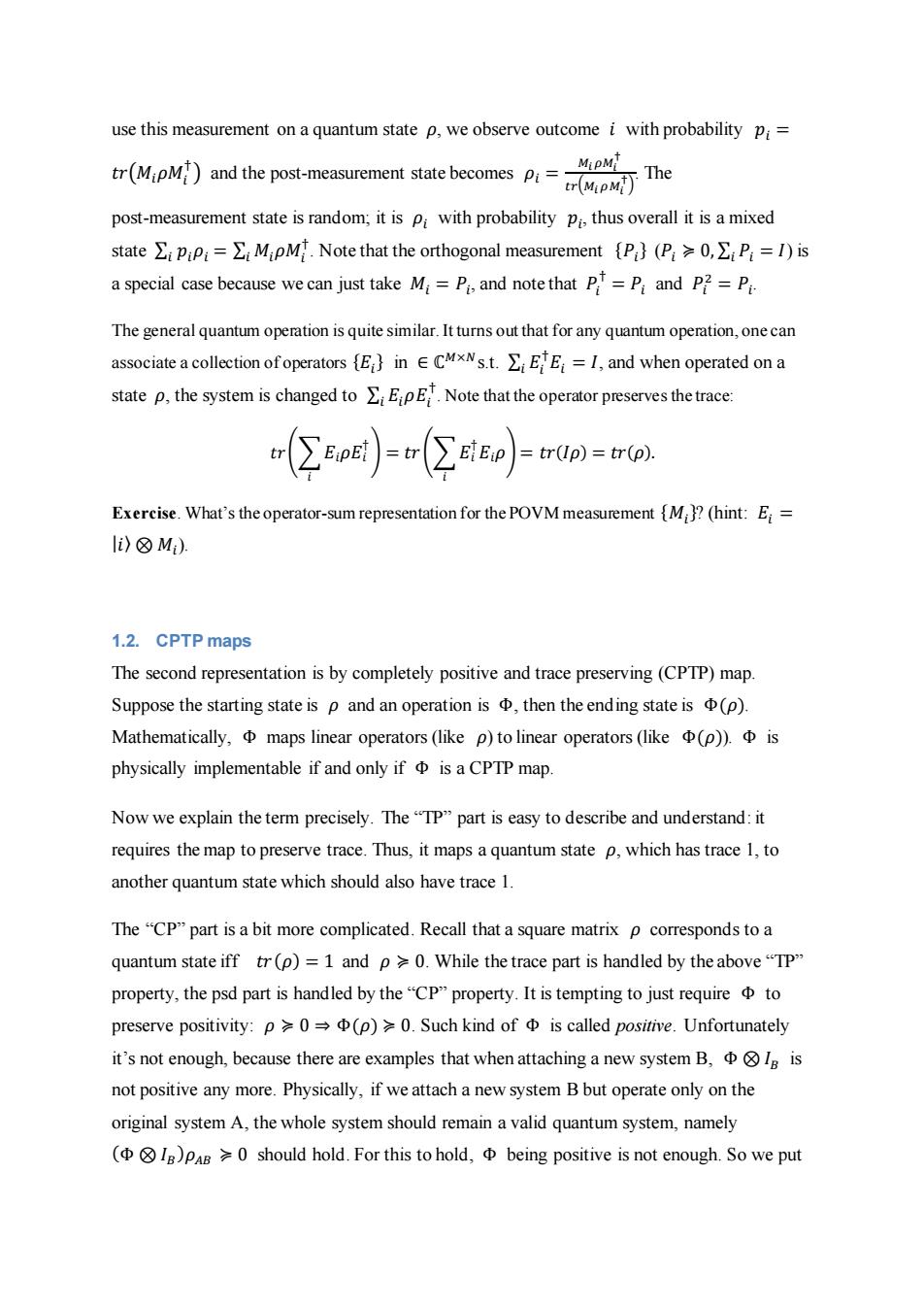正在加载图片...

use this measurement on a quantum state p,we observe outcome i with probability pi= tr(MipM)and the post-measurement state becomes pi=- MipM tr(M The post-measurement state is random;it is Pi with probability pi,thus overall it is a mixed state∑iPiPi=∑iM;pM.Note that the orthogonal measurement{P}(P:≥0,∑:P,=I)is a special case because wecan just take M=Pi,and note that P=P and P2=P The general quantum operation is quite similar.It turns out that for any quantum operation,one can associate a collection ofoperators in ECMxNs.t.EE=I,and when operated ona state p,the system is changed to EipE.Note that the operator preserves the trace: (2ep)=r(2iep) =tr(Ip)=tr(p) Exercise.What's the operator-sum representation for the POVM measurement {Mi?(hint:E= li)☒M) 1.2.CPTP maps The second representation is by completely positive and trace preserving (CPTP)map. Suppose the starting state is p and an operation is then the ending state is (p). Mathematically,maps linear operators(like p)to linear operators (like (p)).is physically implementable if and only if is a CPTP map. Now we explain the term precisely.The "TP"part is easy to describe and understand:it requires the map to preserve trace.Thus,it maps a quantum state p,which has trace 1,to another quantum state which should also have trace 1. The "CP"part is a bit more complicated.Recall that a square matrix p corresponds to a quantum state iff tr(p)=1 and p 0.While the trace part is handled by the above"TP" property,the psd part is handled by the"CP"property.It is tempting to just require to preserve positivity:p≥O→Φ(p)≥O.Such kind ofΦis called positive.Unfortunately it's not enough,because there are examples that when attaching a new system B,Ig is not positive any more.Physically,if we attach a new system B but operate only on the original system A,the whole system should remain a valid quantum system,namely (④⑧la)pas>≥0 should hold.For this to hold,Φbeing positive is not enough.So we putuse this measurement on a quantum state 𝜌, we observe outcome 𝑖 with probability 𝑝𝑖 = 𝑡𝑟(𝑀𝑖𝜌𝑀𝑖 † ) and the post-measurement state becomes 𝜌𝑖 = 𝑀𝑖𝜌𝑀𝑖 † 𝑡𝑟(𝑀𝑖𝜌𝑀𝑖 † ) . The post-measurement state is random; it is 𝜌𝑖 with probability 𝑝𝑖 , thus overall it is a mixed state ∑𝑖 𝑝𝑖𝜌𝑖 = ∑ 𝑀𝑖𝜌𝑀𝑖 † 𝑖 . Note that the orthogonal measurement {𝑃𝑖 } (𝑃𝑖 ≽ 0, ∑𝑖 𝑃𝑖 = 𝐼) is a special case because we can just take 𝑀𝑖 = 𝑃𝑖 , and note that 𝑃𝑖 † = 𝑃𝑖 and 𝑃𝑖 2 = 𝑃𝑖 . The general quantum operation is quite similar. It turns out that for any quantum operation, one can associate a collection of operators {𝐸𝑖 } in ∈ ℂ 𝑀×𝑁 s.t. ∑ 𝐸𝑖 † 𝑖 𝐸𝑖 = 𝐼, and when operated on a state 𝜌, the system is changed to ∑ 𝐸𝑖𝜌𝐸𝑖 † 𝑖 . Note that the operator preserves the trace: 𝑡𝑟(∑𝐸𝑖𝜌𝐸𝑖 † 𝑖 ) = 𝑡𝑟 (∑𝐸𝑖 † 𝐸𝑖𝜌 𝑖 ) = 𝑡𝑟(𝐼𝜌) = 𝑡𝑟(𝜌). Exercise. What’s the operator-sum representation for the POVM measurement {𝑀𝑖 }? (hint: 𝐸𝑖 = |𝑖〉 ⊗ 𝑀𝑖 ). 1.2. CPTP maps The second representation is by completely positive and trace preserving (CPTP) map. Suppose the starting state is 𝜌 and an operation is Φ, then the ending state is Φ(𝜌). Mathematically, Φ maps linear operators (like 𝜌) to linear operators (like Φ(𝜌)). Φ is physically implementable if and only if Φ is a CPTP map. Now we explain the term precisely. The “TP” part is easy to describe and understand: it requires the map to preserve trace. Thus, it maps a quantum state 𝜌, which has trace 1, to another quantum state which should also have trace 1. The “CP” part is a bit more complicated. Recall that a square matrix 𝜌 corresponds to a quantum state iff 𝑡𝑟(𝜌) = 1 and 𝜌 ≽ 0. While the trace part is handled by the above “TP” property, the psd part is handled by the “CP” property. It is tempting to just require Φ to preserve positivity: 𝜌 ≽ 0 ⇒ Φ(𝜌) ≽ 0. Such kind of Φ is called positive. Unfortunately it’s not enough, because there are examples that when attaching a new system B, Φ ⊗ 𝐼𝐵 is not positive any more. Physically, if we attach a new system B but operate only on the original system A, the whole system should remain a valid quantum system, namely (Φ ⊗ 𝐼𝐵 )𝜌𝐴𝐵 ≽ 0 should hold. For this to hold, Φ being positive is not enough. So we put